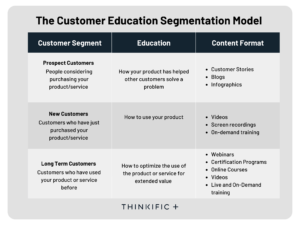Have your customers hit a roadblock in maxing out your product’s potential? Or, are you losing customers at annual renewal time because they’re just not getting any value?
According to CallMiner, U.S. companies lose $136.8 billion per year due to avoidable consumer switching.
If your customers aren’t recognizing the intended value out of your product or service, and are leaving as a result, it’s probably time to start thinking about a customer education program.
Not entirely sure what that means?
Let’s find out.
Related article: Learn how to optimize customer success with customer education strategy.
What is customer education?
At Thinkific, we see customer education as the process of enhancing your customers’ knowledge about your product or service to help them achieve value faster and better scale user growth.
Customer education starts before customers buy your product and continues throughout the customer journey. For example:
- Stage 1: Prospect customers might need education on how your product has helped other customers solve a problem
- Stage 2: New customers might need educating on the basics of how to use your product
- Stage 3: Long-term customers might need education on how to optimize their use of the product for extended value
Ultimately, customer education equips your buyers with the information they need to experience value from your product and want to continue to use it. In fact, when a customer interacts with educational content, their brand affinity compounds over time according to Conductor.
Customer education can be delivered in a number of different content formats, depending on your businesses’ specific goals, audiences and offerings. For example:
- Customer Case Studies: Demonstrate to potential customers how other customers have found success using your product or service
- Blogs and Articles: Ideal for sharing step-by-step guides and detailed instructions on product/service use
- Video and recorded screen-captures: Are a great tool for sharing step-by-step guides, instructional videos, and tutorials that teach new customers the basics on how to use your product or service
- Webinars: Allows businesses to dive deeper into more advanced topics regarding your product or service, answer your customers’ questions, and connect with them more intimately
Benefits of a customer education program
So, you’ve decided to create a customer education program to scale your business and reduce customer churn quickly. That is a great first step!
But, before doing anything else, it is critical to know the value-adds customer education brings to your business.
Let’s take a look.
More flexibility and scalability
In today’s environment, there is a heightened need for flexibility across every element of doing business. That includes customer education.
On-demand education courses let customers deepen their knowledge on their own time. And digital courses are easy to update when content needs to be refreshed.
Then, as your business grows, so can your customer education program. With the right technical tools, you won’t have to sacrifice your program’s reliability because of your growth.
Boosts customer service and interaction
Has your customer service team mentioned it gets the same questions over and over again? That could be a sign your customer education program isn’t up to par.
Slack’s Chief of Staff, Customer Experience, once said, “I think of CE [customer education] as jet fuel for CSMs. Anything we can do to help you build relationships better, faster.”
Solid customer education programs deliver need-to-know information for customers to obtain the real value of the product – and that starts by tackling frequently asked questions.
When an education program addresses the common questions upfront, your customer service team can spend more time having quality interactions with customers and tackling their more in-depth needs.
Faster adoption and onboarding
Just like anyone else, customers value their time. They’ve likely already spent a lot of time and energy researching before deciding to go with your product. Which means, they probably want to get up and running with it quickly.
With an established, on-demand education program, your customers can move through their onboarding at their own pace. That builds customer confidence in using your product and speeds up the adoption process.
Related: Want to improve new customer activation? Check out the recordings from Thinkific Activate Summit.
Improves customer retention
Customers aren’t going to purchase your product and then look for reasons to leave. But they will if they don’t get the information they need to use the tool they’ve spent time, energy, and money on.
That’s why it’s critical to build a customer education program that meets the needs of your users. Customers will remain loyal when they trust your product, feel confident in using it, and quickly recognize value from it.
Take a look at how Later, an Instagram scheduling tool improved retention by 320% after converting their customer onboarding webinar into an online course with Thinkific Plus.
Related article: Check out our customer success strategies guide for more tips on boosting customer education.
Strategically build your customer education program with customer segmentation
When building a customer education program for your business, segmenting your customers can be highly beneficial to help you build a curriculum and learning materials that cater to their specific needs.
Customer segmentation is the process of dividing your customers into groups according to certain facts and characteristics about them. Businesses tend to analyze their audience and create customer “segments” to optimize marketing efforts towards each group, and improve their overall customer journey experience through personalization.
Segmenting customers into groups also allows you to communicate with each group more efficiently and learn more about their behaviors and preferences over time through the process of observation and data collection.
There are countless ways to “segment” your customers depending on your business goals: demographics, geographics, buyer behavior, purchase history, and more.
Consider the Customer Education Segmentation Model below for strategically building your Customer Education Program:

Remember, you need to educate your customers at every stage of their journey. Whether it is before they purchase your product or service, after they purchase, or once they are activated, education is important at every stage to help them understand your offer better and receive the most value.
Segmenting your customers into groups according to which “stage” of the journey they are in when building your customer education program will help you deliver education at the right time through your content, and address your customer’s specific needs, questions, and goals as they interact with your business over time.
Related article: Learn how your customers can benefit from different types of learning.
Five best practices for building a customer education program
Now that you know the positive impacts a customer education program can have on your business, it’s time to start building your program.
Here are some of our tips for launching your first customer education program from scratch.
1. Find the right education platform
Customer education programs can include a combination of verticals, like:
- Traditional in-person training
- Webinars
- Blog posts
- Videos
- Customer success stories
- Downloadable guides and whitepapers
Instead of using a piecemeal approach, it’s best practice to collapse all these channels and media formats into one easy-to-use platform for your customers: a learning management system (LMS) that allows you to quickly and easily build on-demand courses.
Customer Education Platform Checklist
Here’s 5 things you’ll want to keep an eye out for when choosing a platform for your Customer Education Program:
- Customization: Building dynamic lessons and courses with multimedia content in your program will help you keep your customers engaged and motivated to come back to continue their learning journey. Ensure that you choose a platform for your program that allows you to bring your distinct vision to life with flexible content options such as live lessons, unlimited video, communities, assessments, and much more.
- Ease-of-use: To keep your customers engaged and motivated to continue their learning, you will want to make it as easy as possible for them to access your education program and complete the learning materials and lessons. Look for a platform that is built with the user experience in mind, and has powerful, yet easy to use functionality.
- Scalability: As your business scales, so will your customer base and customer education needs. As you grow the number of customers in your audience and expand on your offerings, you will want to select a platform that can scale with you and cater to your businesses’ growing needs without limitations.
- Insights and Progress Tracking: Having an understanding of how your customers are interacting with your education program will allow you to identify areas of opportunity and improvement for the future. To provide a quality learning experience for your customers in your program and continue to optimize your learning content to ensure it provides value, you will want to search for a platform that allows you to track your customer’s learning progress, and can provide insights on their experience as “students”.
- Flexibility: Look for a platform that has everything you need to easily set up, launch and scale your customer education programs and courses. With a platform that allows for flexibility and has no coding required, you will be able to build courses with ease and quickly and efficiently provide education for your customers whenever they need it.
2. Define success
Just like starting any new business process from scratch, it’s important to define success from the very beginning. Make time to outline the program’s vision, near- and long-term goals, and KPIs to measure performance.
Possible goals could include:
- Reducing customer onboarding time
- Decreasing the amount of time customer service teams are spending on training
- Expanding product utilization
- Helping customers adopt more preferred behaviors
3. Start with your customers’ biggest pain points
When it’s time to tackle your strategy, start with the easy wins: your customers’ most common challenges.
Ask yourself these questions:
- What are the most common customer service questions within the first three months of onboarding?
- Are customers grasping the basics? Or, are they making it to the next level of use?
- Where are my customers dropping off in utilization?
- Are they taking the right actions?
- Are there underused features?
Once you have a grasp of the education gap, you can start focusing on content development.
Pro tip: Tap into customer feedback. See if customers regularly suggest more information/materials following their onboarding, and then integrate those concepts into your program.
4. Keep content fresh and interesting
Content is king. Having the right content on the right platform will set you up for success in launching your customer education program. So, how do you get started?
We recommend keeping these three things top of mind when developing content:
- Interactive: Making your education content interactive with quizzes, discussions, and surveys is a great way to keep your customer engaged throughout the learning experience.
- Digestible: With everyone doing more these days, a customer rarely has a ton of time to spend learning a new system or product. Keep their attention by creating bite-sized lessons.
- Informative: Make sure your content packs a punch with easy-to-understand information. Videos, presentations, and tutorials are great content resources that resonate with customers getting up to speed on a new process or system.
5. Optimize, optimize, optimize
Once you get your first customer education program off the ground, it’s time to celebrate!
Then, remember to create a plan to integrate ongoing optimizations to the program based on:
- Customer feedback and interactions
- Course data and metrics
- Updates to existing material
- Customer desires for expanded material
Remember: the more you can help customers build their knowledge from quality training and education, the sooner they realize your offerings’ value and will be more likely to sign up for renewals or expansions.
LMS platforms, like Thinkific, are used every day to create customer education programs. Customers have a greater need now, more than ever to have flexible, online access to product education and training content.
Ready to start educating your customers? Download your free Ultimate Customer Success Guide now.






